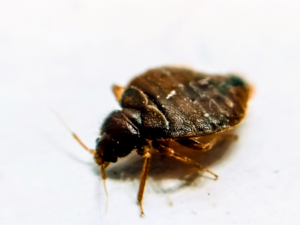Home / Blog / Spiders / What To Do if You Find a Black Widow Spider
What To Do if You Find a Black Widow Spider

Scientifically reviewed by Daniel Baldwin, BCE, CCFS, CP-FS
-Published on September 27, 2024
-Updated on March 19, 2025
Although notoriously recognized for their red markings and feared for their venom, black widow spiders actually tend to avoid humans and their bites rarely result in death. These arachnids may inspire fear, but the truth is their controlled presence can actually be helpful to the home and its environment. Learn more about how to identify black widow spiders, what to do if you find one, and how to prevent infestations in your home.
What Are Black Widow Spiders?
This species of arachnid is scientifically known as Latrodectus, more widely called black widow. All arachnids are identifiable by their eight legs and lack of antennae. Their bodies are divided into two sections, with the thorax in front and the abdomen in the back.
What do Black Widow Spiders Look Like?
A black widow spider is usually quite easy to identify, although they’re not typically out in the open. An adult female black widow has a shiny, black body with a rounded abdomen and is about 1.5 inches long. The markings on her abdomen usually appear as an hourglass shape that’s usually red in color, but it can also be orange, yellow, or even white.
As juveniles, black widows can actually be quite colorful, and as the female spider matures, the colors fade to black except for the red markings, which eventually end up as an hourglass shape. (One of our Hawx team members has come across Black Widow Spiders that have red spots instead!)
Male black widows are smaller, gray or brown in color, and have red or pink spots rather than the hourglass pattern. The male spider is somewhat reclusive and is rarely seen by humans.
Where Do Black Widow Spiders Live?
Black widow spiders live mostly in the southern and western areas of the U.S., although some do live in the northeastern states, too. They thrive in forests, deserts, grasslands, and urban or suburban areas. Black widow spiders like to live near people’s homes because the lights of the house attract insects (their prey) at night.
These arachnids can be found in dark, undisturbed areas, but they may also crawl into areas you’d least suspect, like a pair of gardening gloves lying around. The places you’ll most often find black widows around your home include spots like:
- Stacks of wood
- Brush or leaf piles
- Corners of sheds or garages
- In between loose stones or rocks
- Basement areas and crawl spaces that are rarely disturbed
- Underneath flowerpots
- Inside gardening gloves
- Inside boots or shoes
- Between and around outdoor garbage bins
What Do Black Widow Spiders Eat?
A black widow spider can live for as long as 1–3 years in an environment that provides them with the food they need to eat. These critters build webs to catch their prey. The webs don’t look like the symmetrical webs weaved by orb spiders. Instead, the webs are tangled and messy-looking.
The web serves as a trap for prey, which can include:
- Flies
- Grasshoppers
- Beetles
- Caterpillars
- Cockroaches
- Small vertebrates, snakes, or lizards
The black widow spider bites the captured prey to stun it and then injects it with venom to paralyze it. Then, the spider carries the insect away to consume it.
Although the black widow spider is notoriously known for mating and then eating or killing her mate, this doesn’t always occur. In fact, it only happens in about 2% of black widow spider mating cases. More often than not, the male scurries away quickly after mating. Once baby spiders hatch, though, these offspring can eat their siblings as they emerge from their eggs.
How do You Tell if a Web is From a Black Widow?
A black widow’s web won’t show the neat geometric forms of many other spiders. The pests usually produce tangled, irregularly shaped webs. At first glance, you may even think that you’re looking at a web that has been partially damaged or destroyed due to the odd shape of the webbing.
The location of the web can also provide clues. Black widows typically prefer to build their webs close to the ground.
What Attracts Black Widows?
Black widows come to places where they find food. As a result, houses and apartments with infestations of flies, ants, gnats, fleas, and other pests are more likely to become home to black widows.
Once inside, black widows are most likely to linger if they find dark, hidden areas. They tend to like warmer places in a home.
Why do I Have so Many Black Widows Around My House?
If you have many black widow spiders around your home, you likely have dark places for other pests to hide. Clutter, like gardening tools and furniture, can provide hiding places. Your property is also more likely to draw the spiders if you have leaves and lawn clippings in your yard or keep wood piles unprotected. Rotting stumps left over from tree removal may also attract black widows.
Are Black Widows Dangerous To Humans?
Black widow spiders are not naturally aggressive toward humans, but they will bite if they feel threatened—like if a person unknowingly reaches into its territory and disturbs it.
The venom of black widow spiders has been found to be 15 times stronger than that of a rattlesnake, gram for gram (luckily the amount you’d get into your system is much less than you’d get from a rattlesnake bite). A black widow bite can cause reactions in humans, although the bites rarely result in fatalities.
What To Do if You Find a Black Widow Spider
If you find a black widow spider on your property, chances are very good there are more of them around. Black widow spiders are fast movers, especially if they feel threatened. You can try using an insecticide spray or vacuuming up the spider, but the safest thing to do is to call a professional pest company.
To keep them out of your home, seal any entry point gaps with foam or caulk near the foundation. Keep kitchens and other areas clean and free of food that might attract insects inside. This will keep black widow spiders out too, since there will be no prey for them to eat inside.
A few other tips for preventing black widows include:
- Minimizing clutter or places spiders like to hide
- Keeping firewood away from the home
- Inspecting yard waste or potted plants before bringing them inside the house
How to Get Rid of Black Widow Eggs
If you encounter black widow eggs, don’t try to remove them yourself. The best way to deal with eggs is to contact a pest control company as soon as possible.
Licensed pest control technicians can use products and tools to treat spider eggs before they hatch safely. Some of these treatments may also help eliminate adult black widows in the area.
How To Get Rid of a Black Widow Infestation
Since black widow spiders can bite and become aggressive when threatened, it’s best to call in a professional pest service like Hawx Pest Control to safely keep these arachnids from inadvertently causing harm to humans. Professional spider services include routine tasks and checks that reduce an infestation of black widow spiders and protect your property from their return.
Related Articles
Visit our blog to learn more.
→








